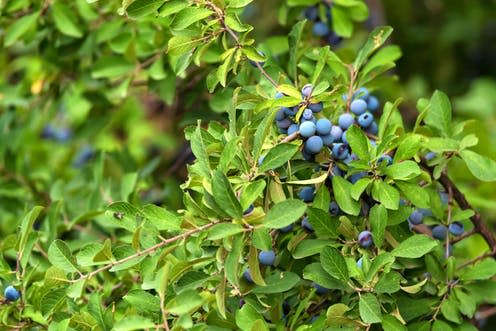Growing bigger prickly hedges can reduce the chance of extreme weather – and a lot more

In highlighting how Britain lost half its hedgerow network in only 75 years following the post-WWII move to modernise farming, a recent report from the Council for the Protection of Rural England points out how hedgerows can reduce climate warming by naturally helping to remove CO₂ from the atmosphere.
Simply allowing existing hedges to get bigger could double overall carbon sequestration capacity (the process of capturing and storing atmospheric CO₂). The build-up of “greenhouse” gasses such as CO₂ causes the atmosphere to warm, which in turn increases the likelihood and severity of extreme weather events, such as flooding, wildfires and hurricanes.
The CPRE argue that a 40% increase in the UK’s hedgerow cover could provide a net CO₂ sequestration potential of 18.5 million tonnes. That may be a fraction of current UK CO₂ emissions 354 million tonnes in 2019, but the potential contribution to the climate problem is significant.
What can hedges do for the climate?
As ecologists we have to worry about many things: invasive species, habitat loss, overexploitation and pollution. But climate change is the big one.
Plants naturally capture carbon during the process of photosynthesis, the process of producing food for the plant to survive. The ability to couple CO₂ with water and generate sugar using solar energy is the most remarkable and important event in evolutionary history and might just help us prevent climate catastrophe by naturally capturing this key greenhouse gas.
Although the ability to sequester carbon varies between tree species and different management practices, it is estimated that mixed hawthorn/blackthorn hedges (the most common species in British hedgerows) can store up to 42 tonnes of carbon per hectare.
The most extreme (yet wholly credible) scientific predictions for how climate change will affect the planet are so harrowing that I don’t even tell my final year undergraduate students. What is clear is that if humanity does not take responsibility at the COP26 meeting in Glasgow (the 2021 United Nations climate change conference), it is probably too late to completely mitigate the consequences. But it appears that there are some actions that can help - and growing more hedgerows may be one of the easiest ones.
Read more: How summer 2021 has changed our understanding of extreme weather
Hedgerow heritage
Hedgerows should be the farmer’s friend, but after Hitler’s U-boats threatened Britain’s food supplies during the second world war, post-war governments impressed the need for agriculture to modernise. In came a raft of chemical fertilisers, pesticides and larger machinery. Out went intimate fields and the web of hedges established around them hundreds of years earlier.
Farmers actually received grants to grub them out, many doing it simply because they were paid to, rather than any obvious benefit to farming efficiencies. It is only since they disappeared that it has become apparent that they actually contributed a great deal to agricultural production and the wider rural landscape.
I am lucky enough to live in a part of the UK that still has hedgerows. They are among the numerous features that delight the summer influx of migrants to south-west England. Many older visitors recall the rural landscape of their youth and the traditional hedges around fields. Thanks to hedges, late spring brings a kaleidoscope of red campion, bluebell and the white flowers of stitchwort to the roadsides of Devon and Cornwall. With the flowers comes a posse of insects competing for the nectar and pollen these flowers provide.

Aesthetics are, however, only part of their value. Bees and hoverflies that feed from, and make their homes in, Britain’s hedgerows provide a key pollination service to farmers. Other insects spill out from the hedgerow to prey on crop pests and so contribute another critical ecosystem service to society. Simply retaining a living biological structure around the edges of fields helps retain soil and filter out agrichemicals that might otherwise leach into the wider environment.
Modest investment
A relatively modest taxpayer commitment of £310 million over 28 years (less than £10 per working adult in the UK) could attract a near four-fold return on investment, with additional benefits for job creation, cleaner air and enhanced water use.
The CPRE also argues that urban planting might also have major benefits for mental health and well being with plenty of scope to increase upon the mere 38% of urban roads with any form of hedgerow at present. It is also likely that reinstatement of rural hedgerows will make the countryside more attractive for visitors, says the CPRE.
The UK government will need to offer targeted subsidies to farmers and other land managers to replant hedgerow trees and then manage them in appropriate but well understood ways to maximise carbon-capture and biodiversity potential. There was a system of well-established and broadly successful EU agri-environment schemes in place in Britain before Brexit to encourage hedgerow expansion and management.
The National Farmers Union is lobbying government to replace and improve these schemes, but even with legislation and appropriate government support, it takes time to reinstate biodiversity.
That said, I planted a native hedge instead of an expensive, wind-catching fence when I moved house ten years ago, and saw that it was possible to grow a two-metre tall, biodiverse hedgerow within a decade. Surely if I can do it in my back garden, farmers can do even better.
This article is republished from The Conversation under a Creative Commons license. Read the original article.

Mick Hanley receives funding from The Leverhulme Trust and The Natural Environment Research Council

 Yahoo News
Yahoo News 